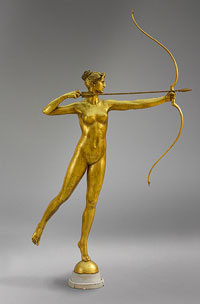MET Features Work of Renowned 19th-Century American Sculptor and Metalist Augustus Saint-Gaudens
 Diana, 1892-93, Augustus Saint-Gaudens
Diana, 1892-93, Augustus Saint-GaudensCourtesy of the Metropolitan Museum of Art
On view now through October 12, the Metropolitan Museum of Art presents a collection of works by metalist Augustus Saint-Gaudens (1848-1907), a French-Irish immigrant who became the greatest American sculptor of his day. From humble roots, through his prodigious talent, he rose in society, eventually counting some of America's most influential people in art and literature, diplomacy and economics, technology and social policy among his friends and clients. The collection of The Metropolitan Museum of Art contains nearly four dozen works by the accomplished artist, representing the entire range of his oeuvre, from early cameos to innovative painterly bas-reliefs to character-penetrating portrait busts and statuettes derived from his public monuments. These unparalleled holdings will be supplemented with loans from private collections and public institutions in the exhibition Augustus Saint-Gaudens in The Metropolitan Museum of Art. The presentation will address the artist's groundbreaking position in the history of late-19th-century American sculpture, his role in advancing American art on the international stage, and the long history of presenting and collecting his work at the Metropolitan Museum.
Davida Johnson Clark, Saint-Gaudens's model and mistress, was an inspiration for Diana, an 18-foot-tall, gilt sheet-copper weathervane that once topped the tower of Stanford White's Madison Square Garden. In addition to a plaster portrait of Miss Clark, the exhibition will feature a 6-1/2-foot gilt-bronze version of Diana (modeled 1893-94, cast 1894 or after) that has long been the centerpiece of the Engelhard Court and an elegant Diana statuette (1893-94, cast 1894 or after).
Saint-Gaudens's last major public memorial was the Sherman Monument (located in Grand Army Plaza, New York). In this gilded-bronze equestrian monument, one of Manhattan's finest public sculptures, General William Tecumseh Sherman is led on his horse by a winged classicized Victory. She bears traditional attributes-a laurel crown and a palm leaf-and is depicted by the artist as a guiding force. Her outstretched right arm leads the obedient horse, upon which sits a battle-hardened General Sherman. Saint-Gaudens painstakingly arranged drapery on numerous nude models for Victory before settling on what he believed was the perfect flow of her robe. In a letter to his niece, the artist wrote, "It's the grandest Victory anybody ever made. Hooraah!"
Highlights of the exhibition include a bronze bust of General Sherman modeled from life (1888, cast 1910); a bronze Head of Victory (1897-1903, cast 1907); and the gilt-bronze statuette Victory (1892-1903, cast 1912 or after [by 1916]), reduced after the full-sized figure. Also included will be a section on Saint-Gaudens as a master medalist. A highlight will be the high-strike versions of United States $10 and $20 gold coins, considered by many to be the most beautiful examples of American currency ever struck. The exhibition will close with images of Saint-Gaudens by other artists. Examples are two etchings by Anders Zorn (1897 and 1898); two oils-one by Kenyon Cox (1887, replicated 1908) and Ellen Emmet Rand (around 1904); and a bronze bust by Saint-Gaudens's one-time assistant John Flanagan (1905-24, cast 1924).
Resources:
Also in this Issue:
- Schtiller & Plevy: A Commitment to Restoring History
- Gregory Nangle: Outcast Studios
- The Movement of Bronze: Andrew DeVries
- Capturing the Wild West Through Bronze
- MET Features Work of Renowned 19th-Century American Sculptor and Metalist Augustus Saint-Gaudens
